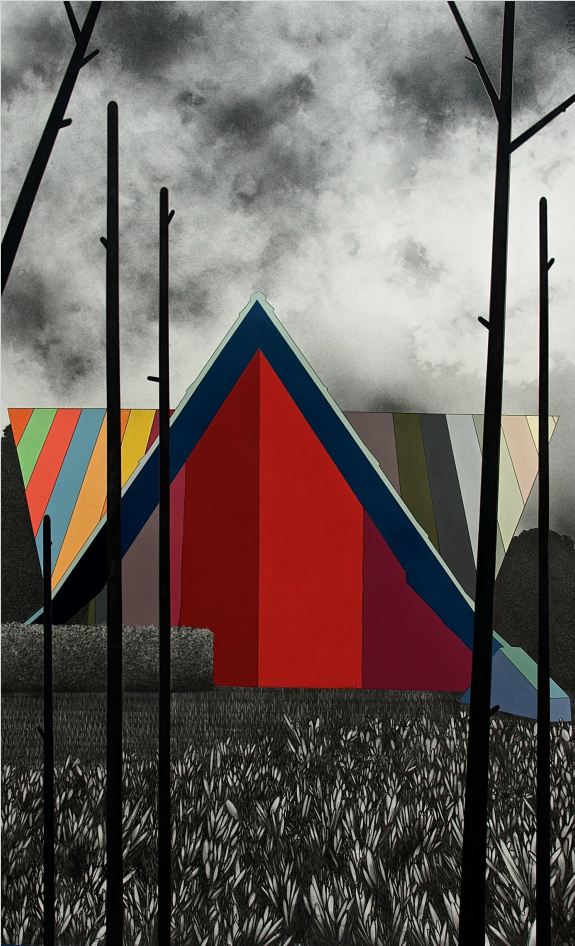Check out our recent Dwell publication on Skyview here. Thanks to Anna Jones.

Check out our recent Dwell publication on Skyview here. Thanks to Anna Jones.

Come on over and check out our newly completed La Grange pool house project! Tucked into a grove of gnarly oaks on the edge of a limestone bluff, this shade structure and zero edge pool work together to frame stunning views of the valley below.
Fresh photography by Leonid Furmansky.

One of the most important design decisions that we make in every project is the material selection for a building’s exterior envelope. Offering protection from the elements, it also determines visual identity through color, texture, and variation. Performance, visual appearance, and maintenance requirements vary with each material option, whether it is stucco, masonry, or wood. Knowing the implications of each system helps achieve desired results.
On a recent project we used a wood rainscreen system for both its performance qualities and aesthetic appearance. Wood rainscreens differ from traditional wood siding in that they introduce a drainage plane between the vapor barrier and the cladding. This drainage plane allows air to circulate behind the wood cladding, thus allowing the whole system to dry out quickly. Any water or moisture that makes its way behind the wood will drain out or evaporate. For this system to work properly, there must be ventilation at both the top and bottom.
The system is made up of multiple layers that function together. The innermost layer is the vapor barrier applied over the sheathing. The middle layer is the battens that form the drainage plane (3/8” minimum), and lastly comes the wood itself.

We worked closely with the contractor to arrive at the final rainscreen configuration. This particular system uses Dupont rainvent product as the field batten, and Cor-a-Vent Sturdi battens with insect barriers at the top and bottom.

In addition to the performance characteristics, a rainscreen system allows for low profile trim resolutions at the top and bottom of the wall. The iconic shape of the gable reads clearly as defined by the wood, without the chunky trim of standard wood cladding. A custom brake metal profile at the top captures the end grain of the wood with a minimal amount of lap to create a very thin border.

The wood itself is 7/8” kiln dried cedar custom milled Texgap profile. The Texgap profile combines the visual appearance of shiplap with the stability of tongue and groove joints. Cedar, a naturally rot resistant wood species, performs well in exterior applications and will last a long time in a rainscreen application.

Stay tuned for the next installment where we'll discuss the process of finishing cedar for exterior cladding!


Check out the recently posted Barton Hills Addition on our website. This renovation, addition and landscape project features an expansive window wall with custom steel window frames and tapered parallel strand columns. Images by Andrea Calo.

Murray Legge will be speaking in the keynote event of Doors Open Toronto 2017: What is Canadian Architecture?
The panelists include:
A.J. Diamond - Diamond Schmitt Architects
Omar Gandhi - Omar Gandhi Architect
Valerie Gow - Gow Hastings Architects
Murray Legge - Murray Legge Architecture
Susan Scott - Scott & Scott
Pierre Thibault - Atelier Pierre Thibault

One of Austin's great buildings is the Seaholm Intake Building. Its reuse has been discussed for several years. We've written an article about the importance of this building in the current issue of Texas Architect magazine. The print edition includes wonderful photography by Leonid Furmansky including the image above.

For more information on this project, and on the history of the Calcasieu cottage, see our previous post "Calcasieu Restoration."

The existing conditions of the roof structure of the Calcasieu cottage present a dramatic vaulted form on the exterior - something entirely absent from the interior due to low ceilings and cellular rooms.

A digital study of the cottage reveals a delicate structural assembly.

A physical model of the cottage helps in understanding spacial conditions.

The existing attic hides the form of the roof structure on the interior. The space is uninhabitable and uninsulated.

A reworking of the interior will be necessary to express the vault. The 8'-0" ceiling should be demolished, the walls removed, and the space opened.

The model helps to visualize the desired outcome.

Careful work is done to preserve the exterior of the Calcasieu cottage. No modifications are made to the existing roof shape.

The structure is delicate and requires additional 2x8 rafters.

The new rafters are sistered onto the existing structure so as to not interrupt the original form.

A pyramid shape is achieved with limited intervention.

Open cell spray foam insulation creates a thermally efficient roof – an improvement over the original uninsulated attic.

A window illuminates the geometry of the vault and provides a slice of western light.

Collar ties provide structural stability in both directions.

The finished interior reveals the structure of the roof, creating an expansive, light filled room.

New custom paint-grip roof panels maintain the small scale of the original 12" standing seam spacing.
Excellent work by Pilgrim Building Company, Enabler, and Straight Solutions.

Sara Frantz - Burger Boy
Murray Legge, along with Norma Yancey and Alisa West, will be participating in a panel discussion focusing on the work of artist Sara Frantz. The panelists will consider the impact of the built environment upon our perception of nature as explored in the artist's large format paintings.
Sara's work can be found on display at Women and Their Work until March 19th.
Join us for the panel discussion on Wednesday, March 4th at 7:00 p.m. Admission is free!
Women & Their Work
1710 Lavaca St.
Austin, TX